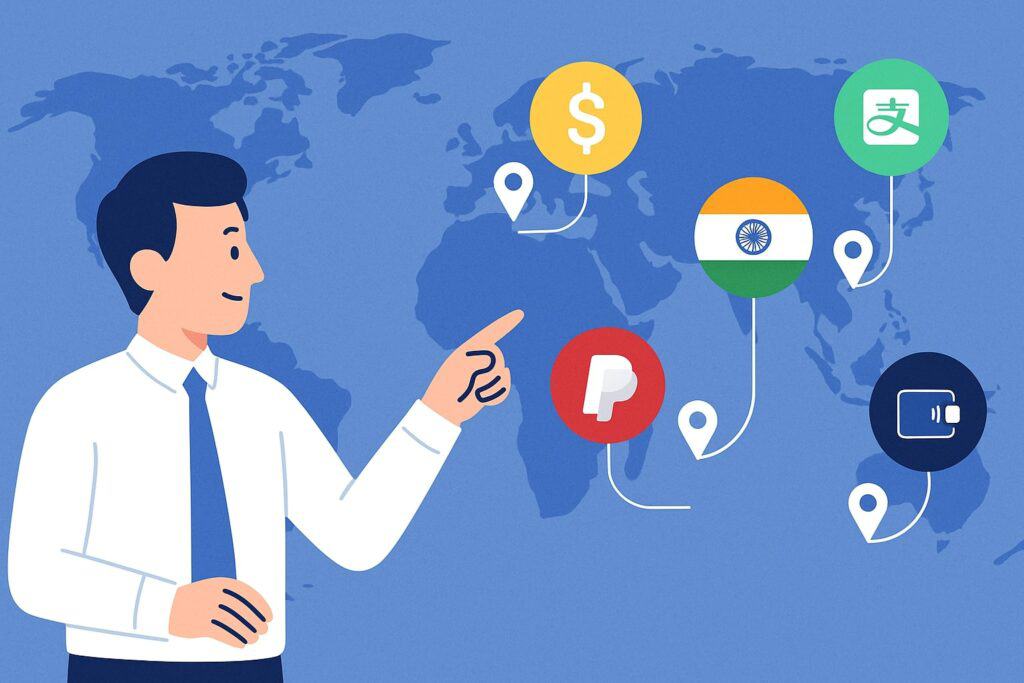
By crossborderfees October 11, 2025
Expanding beyond your home market is exciting—until your conversion rate drops when foreign shoppers reach the final step. The truth is simple: if you want to improve checkout for international customers, you must design every stage of payment, compliance, and fulfillment for cross-border realities.
Global buyers face different currencies, languages, address formats, authentication rules, taxes, and preferred ways to pay. Each mismatch adds friction and drives abandonment. Studies consistently show overall checkout abandonment hovering around ~70%, so even small international hurdles can be costly when layered on top of normal UX issues.
Optimizing your international checkout means aligning with local payment habits, complying with regional security mandates, validating addresses correctly, showing landed costs up front, and engineering resilient authorization and fraud flows.
In this comprehensive guide, you’ll learn practical, up-to-date tactics backed by current payment trends and standards so you can improve checkout for international customers without guesswork.
We’ll cover currency and pricing strategy, local payment methods, SCA/3DS requirements, network tokenization, shipping and address validation, fraud controls, and the metrics that matter. Use these patterns to build a checkout that feels local everywhere—boosting trust, conversion, and lifetime value for your global audience.
Build a Localized Pricing & Currency Strategy That Reduces Cognitive Load

To improve checkout for international customers, start with what they see first: prices. Currency confusion forces shoppers to run mental math while worrying about bank FX fees and final totals.
Display prices in the shopper’s local currency by default, using geolocation and browser locale as hints, and always let users switch currencies with a visible toggle. If your platform supports true multi-currency processing (pricing, authorization, capture, and refunds all in local currency), adopt it to avoid mid-checkout conversions that can surprise cardholders.
Complement currency with localized psychological pricing (e.g., ¥, ₹, R$, ₩ conventions; decimal/comma differences) and concise fee transparency. This is essential when selling in markets where card issuers may apply dynamic currency conversion or international usage fees.
Clarity on landed cost—including duties, VAT/GST, and brokerage—dramatically improves trust. Many cross-border returns and chargebacks stem from unexpected import charges at delivery.
Offer duties-paid shipping options (DDP) where possible, and estimate taxes at checkout using the shipping address and product HS codes. When you improve checkout for international customers, you reduce uncertainty by showing a single “you’ll-pay” total and explaining who collects which part (merchant vs. carrier).
Finally, cache common currency rates daily from a reliable provider and be explicit about your rate source and update cadence. This keeps pricing steady enough for UX while remaining fair and predictable for global buyers.
Evidence is clear: cutting friction—especially around totals—shrinks abandonment and lifts conversion.
Offer the Right Local Payment Methods (LPMs) and Digital Wallets by Market

If you want to improve checkout for international customers, you must accept how fragmented global payment preferences have become. Cards remain important, but many markets favor APMs (alternative payment methods) like account-to-account rails and instant bank schemes.
In Brazil, Pix dominates online payments; in India, UPI is ubiquitous; in the Netherlands, iDEAL has long been essential; in Poland, BLIK is mainstream; and in Belgium, Bancontact matters.
Across regions, digital wallets (Apple Pay, Google Pay) continue to grow, while Europe and APAC show increasing appetite for account-to-account and BNPL solutions.
The fastest path to improve checkout for international customers is to localize your payment options by IP/location, shipping country, or explicit buyer selection—surfacing familiar logos in the first fold of your payment step to create instant trust.
Worldpay’s and market analyses highlight wallets and account-to-account as leading growth vectors in e-commerce, reinforcing the need to localize acceptance.
Operationally, plug into a PSP that provides a single API for multiple local methods and handles settlement, reconciliation, and refunds in local currencies. Map methods to order values and risk levels (e.g., require higher-assurance methods for high-ticket orders).
Provide method-appropriate flows: redirect bank schemes should open in optimized overlays; wallet buttons should appear above card fields; installment/BNPL options should precompute monthly costs. Above all, avoid a “wall of logos.”
Use progressive disclosure: show the top three region-relevant methods first, with a “More ways to pay” expander. This keeps the interface clean while ensuring buyers instantly see a method they trust—arguably the single most powerful way to improve checkout for international customers and reduce abandonment at the payment step.
Meet Global SCA & 3-D Secure Requirements Without Killing Conversion

Security mandates are non-negotiable in many regions. In the EEA and UK, PSD2’s Strong Customer Authentication (SCA) requires multi-factor authentication for most electronic payments.
The cleanest way to comply—and improve checkout for international customers—is to support EMV 3-D Secure (3DS) v2.x, which enables richer, low-friction authentication when issuers can trust device signals, merchant risk data, and exemptions.
Critically, different jurisdictions extend or refine SCA guidance over time (e.g., France soft-decline treatment for non-3DS exemptions; Japan’s guidance to apply 3DS2 for card payments).
Your PSP should automatically apply the right authentication strategy per market, transaction type, and exemption eligibility, falling back to step-up only when necessary. This keeps legitimate customers moving while satisfying regulators and issuers.
To minimize conversion hits, pass full 3DS data elements (shipping/billing match, account age, prior transactions, device channel, and merchant risk indicators).
Support 3DS 2.2+ features like decoupled authentication and trusted beneficiaries where issuers allow them, and ensure your front end is optimized for in-app and mobile web challenges. Done well, SCA becomes a conversion tool rather than a tax: false declines fall, fraud drops, and issuer trust improves.
This is a decisive way to improve checkout for international customers because buyers see authentication that matches local expectations (e.g., bank app push in Europe or Japan), instead of confusing SMS OTPs that feel risky or fail when roaming.
Keep your policy pages updated and explain why authentication occurs in particular markets—transparency builds confidence and reduces support tickets.
Use Network Tokenization to Lift Authorization Rates and Reduce Declines
A foundational lever to improve checkout for international customers is network tokenization—replacing PANs with lifecycle-managed tokens from the card networks (Visa, Mastercard, etc.).
Tokens protect credentials and synchronize with issuer updates (new card numbers, reissued cards), which improves authorization rates and reduces “do not honor” declines caused by stale data.
The scale and momentum are clear: Visa reports more than 10 billion network tokens issued globally, and industry groups indicate a large and growing share of transactions now use tokens.
Merchants adopting network tokens often see higher acceptance, fewer fraud chargebacks, and smoother recurring or card-on-file experiences, especially across borders where issuer risk controls are tighter.
To implement, enable tokenization directly through your PSP or via network token services (e.g., VTS, MDES) and pair it with account updater and credential-on-file flags.
Combine tokens with wallet rails (Apple Pay, Google Pay), which already deliver network tokens plus device cryptograms—helping you improve checkout for international customers without extra UX steps.
Keep routing flexible: send tokenized transactions with all available data (DSRP indicators, 3DS frictionless data, rich AVS/CVV results) to maximize issuer confidence. In subscription or marketplace scenarios, tokens reduce involuntary churn when cards expire.
In short, tokenization is not only a security upgrade; it’s a conversion feature that quietly fixes international acceptance pain where you can least afford friction: the authorization hop.
Design Forms for Global Addresses, Names, and Phone Numbers
A fast way to improve checkout for international customers is to stop forcing foreign addresses into domestic templates. Many countries don’t use the same field order, number of lines, state/province names, or postal code patterns. Some don’t require a postcode at all; others demand strict formats. Names and phone numbers vary widely, too.
Instead of a one-size-fits-all form, dynamically adapt your address fields to the selected destination country: label and order fields appropriately, provide inline examples (“e.g., 28013 Madrid”), and validate lightly using country-specific rules—not aggressive regexes that reject legitimate formats.
Reference global addressing standards and databases to keep formats correct as postal systems evolve. This single fix removes a huge source of form errors and back-office manual reviews.
Auto-complete can further improve checkout for international customers. Use a privacy-respecting address lookup that supports non-Latin scripts and transliteration where necessary (e.g., Japanese, Korean).
Let customers enter addresses in native script, but also store a Latin-script version for carriers that need it. Apply intelligent phone input with automatic country code detection and E.164 formatting.
For names, avoid mandatory “First/Last” splits in cultures where that doesn’t map cleanly; offer a single “Full name” field if in doubt. Finally, never force ZIP+4-style extensions on countries that don’t use them, and clearly state shipping limitations up front (e.g., PO boxes, remote areas).
These UX niceties dramatically improve checkout for international customers, cutting failure loops that cause abandonments right before payment.
Present Duties, Taxes, and Shipping Options Up Front (No Surprises)
Nothing derails a great international checkout like unexpected import fees or slow, opaque shipping. To improve checkout for international customers, calculate duties, VAT/GST, and fees in real time based on the cart, HS codes, and destination.
Offer Delivered Duty Paid (DDP) where feasible so customers prepay everything at checkout and avoid “pay at door” surprises. Even when DDP is unavailable, present a reliable estimate with a clear disclaimer and links to your tax policy.
Provide multiple shipping speeds with accurate delivery windows by country, including fast-track options for major metros and consolidated economy for price-sensitive buyers.
Be explicit about who the importer of record is and how returns work cross-border. For each option, show the total landed cost and whether duties are refundable on returns. Show fuel surcharges or remote area fees early to avoid sticker shock.
Then, reinforce trust with proactive tracking links, localized carrier names where possible, and SMS/email notifications in the buyer’s language.
This transparency improves checkout for international customers by removing the anxiety of “What will I actually pay?”—a leading reason global shoppers bounce right before purchase, especially on mobile, where attention spans are short.
Aligning shipping clarity with localized payment preferences and address-aware forms creates a cohesive global experience that converts.
Reduce Friction With Smart UX Patterns That Travel Well
To improve checkout for international customers, your UX must be both minimal and context-aware. Collapse your checkout into as few steps as practical, but don’t hide essential information buyers in some countries expect to see (e.g., tax ID/VAT fields for business customers, invoice requests, or CPF/CNPJ in Brazil).
Use guest checkout by default; account creation should be optional and deferred. Surface the most relevant payment methods first, prefill country and currency, and keep all fields keyboard-friendly with mobile number pads.
Progress indicators should be clear, and error messaging must be localized and respectful—never blame the user for failed bank authentications or card declines.
Make wallets and one-tap options highly visible on mobile, and pre-detect the card brand to show the correct CVV hint and installment availability where customary. Provide online exchange-rate info and bank fee caveats when you must settle in a different currency.
Compress images and defer non-critical scripts to speed up initial paint globally. Lastly, handle recoveries gracefully: if authentication times out or a bank redirect fails, return the shopper to a stable payment selection screen with their cart intact.
Each micro-interaction compounds into a tangible lift, helping you improve checkout for international customers while keeping the interface calm under cross-border complexity.
Current industry research underscores how checkout friction drives abandonment; trimming friction universally helps, and it’s pivotal in cross-border scenarios where trust is fragile.
Balance Fraud Prevention With Acceptance—By Region
Fraud profiles change dramatically across markets. Over-zealous filters create false declines that quietly crush international revenue. To improve checkout for international customers, tune risk per country, payment method, and device signal.
Use layered signals: device fingerprinting, velocity controls, geodistance checks (IP vs. shipping), and behavioral analytics. Feed 3DS data into your risk models; frictionless approvals post-SCA are a strong trust indicator.
Prefer network tokens and wallets, which ship stronger cryptographic signals and often yield better issuer approval rates. Where Address Verification Service (AVS) is weak or unavailable internationally, lean more on 3DS, device, and historical customer data rather than AVS mismatches that can wrongly penalize legitimate foreign addresses.
Invest in post-authorization monitoring. Review issuer decline codes by market to detect where 3DS, tokenization, or routing changes could lift approvals. For subscriptions, mitigate involuntary churn with account updater and retry logic tuned to local banking cycles.
Present clear return and refund policies during checkout—fraudsters aside, many chargebacks stem from poor expectations management on taxes, shipping times, or descriptors. Remember: your goal is not zero fraud; it’s optimal acceptance.
The right balance will improve checkout for international customers by letting good buyers sail through while systematically squeezing out bad actors, country by country.
Engineer Payments for Reliability: Routing, Retries, and Resilience
Technical excellence is a hidden superpower when you improve checkout for international customers. Cross-border payments traverse more hops: local acquirers, schemes, authentication servers, and sometimes domestic switches.
Build intelligent routing that selects regional acquirers with strong domestic connections, supports local BIN ranges, and respects data residency requirements. Implement soft-decline recovery with 3DS step-up when issuers ask for SCA.
Separate network and gateway timeouts from true declines, and design idempotent capture/refund operations to prevent double charges during transient failures.
Use smart retry logic: for “issuer unavailable” or “do not honor” codes, retry once with a different route or after brief backoff; for “insufficient funds,” offer another method immediately (e.g., local RTP) rather than mindless retries.
Monitor authorization rates by country, method, issuer BIN, and tokenization status. If network tokens underperform with certain issuers, A/B test PAN vs. token routes until issuer configurations catch up.
Over time, these engineering patterns improve checkout for international customers by making payments feel instant and reliable across continents—even when the underlying rails are having a bad day.
Measure What Matters: Metrics and Experiments for International Checkout
You can’t improve checkout for international customers without rigorous measurement. Track funnel metrics by country, currency, device, and payment method: checkout start rate, field error rate, 3DS challenge rate, frictionless pass rate, authorization rate, and post-payment chargebacks/returns.
Attribute abandonment reasons when possible (UI error, authentication failure, bank decline, duties shock). Compare wallet vs. card performance, tokenized vs. non-tokenized authorizations, and SCA exemption success by issuer and market. Tie everything to absolute revenue lift, not just percentage conversion.
Run controlled experiments with one change at a time: re-ordering payment methods, adding Pix/UPI, enabling network tokens, moving to DDP shipping, or tweaking 3DS data fields. Watch for Simpson’s paradox across segments; what helps in Germany may hurt in Mexico.
Use cohort analyses to understand LTV impact of speedier checkout (wallets often yield higher repeat rates). Industry sources show abandonment remains stubbornly high overall; disciplined testing is how you beat the baseline for each market and steadily improve checkout for international customers in ways your competitors can’t easily copy.
Implementation Checklist: Fast Wins to Improve Checkout for International Customers
To help you move from strategy to execution, here’s a prioritized checklist to improve checkout for international customers quickly and safely:
- Currency & totals: Default to local currency with a visible switch; show a single landed cost including duties/taxes.
- Local methods: Enable the top 2–3 LPMs per market (Pix, UPI, iDEAL/BLIK/Bancontact, local wallets) and place them above card fields.
- SCA/3DS: Turn on EMV 3DS 2.x with full data sharing; follow local guidance (EEA/UK PSD2, France soft-declines, Japan 3DS2).
- Tokenization: Use network tokens + account updater; prefer wallets for cryptographic assurance and higher approvals.
- Address & phone: Country-aware forms, light validation, native-script support, E.164 phones, and clear examples per country.
- Shipping: Offer DDP when possible; display delivery windows and fully landed costs; provide localized tracking.
- Fraud vs. acceptance: Calibrate risk per market; leverage 3DS signals and device data; avoid over-reliance on AVS.
- Reliability: Add smart routing, graceful retries, and idempotency; monitor approvals by BIN and tokenization status.
- Experimentation: AB test method order, wallet prominence, and shipping disclosures; measure by market and device.
- Support: Localize error messages, FAQs, and receipts; outline returns/tax policies upfront.
These steps build momentum and compound quickly, delivering a checkout that feels native in every market.
FAQs
Q1) What is the biggest driver of international checkout abandonment?
Answer: The dominant issue is friction: unfamiliar payment methods, unclear totals with duties/taxes, and extra steps for security. Global abandonment rates hover near ~70%, so any added cross-border friction amplifies drop-off.
Showing local currency and accepted local methods up front, plus using 3DS 2.x correctly, tends to produce the largest immediate gains to improve checkout for international customers.
Q2) Do I really need 3-D Secure everywhere?
Answer: Not everywhere, but in EEA/UK it’s mandated under PSD2 SCA for most electronic payments, and some countries (e.g., Japan) have adopted guidance that effectively requires 3DS2 for card payments.
Your PSP should apply exemptions where legal and appropriate, but supporting EMV 3DS 2.x is table stakes to improve checkout for international customers without compliance risk.
Q3) Will network tokenization actually increase my approval rate?
Answer: In many cases, yes. Network tokens help keep credentials fresh and secure, which issuers reward with better authorization outcomes.
Visa reports surpassing 10B tokens issued, and merchant/industry bodies cite meaningful shares of transactions processed via tokens—evidence of maturation and value. This is one of the quietest ways to improve checkout for international customers at scale.
Q4) Which local payment methods should I add first?
Answer: Start with what’s most used in your target markets: Pix in Brazil, UPI in India, iDEAL or its successors in the Netherlands, BLIK in Poland, Bancontact in Belgium, plus major wallets globally.
Review reputable annual reports and your analytics to choose the top two or three per market. That focus yields the fastest lift to improve checkout for international customers.
Q5) How do I handle international addresses correctly?
Answer: Use country-aware forms and validation aligned with postal standards. Don’t force domestic field assumptions on foreign addresses, and support native scripts with transliteration.
Following UPU addressing best practices and databases helps prevent failed deliveries and form errors—an easy way to improve checkout for international customers.
Conclusion
To truly improve checkout for international customers, think like a local in each market you serve. Local currency and transparent landed cost answer the “How much will I pay?” question. Local payment methods and wallets answer the “Can I pay how I want?” question. EMV 3-D Secure 2.x and sound fraud strategy answer the “Is this safe?” question.
Country-aware address and shipping flows answer the “Will it arrive smoothly?” question. Under the hood, network tokenization, smart routing, and robust retries raise approvals and reliability, silently compounding your gains. Finally, measure relentlessly and iterate—what lifts conversion in one country might not in another.
Abandonment is stubborn, but it’s not destiny. By implementing the practices in this guide—and validating with market-level experiments—you’ll improve checkout for international customers and convert more of the demand you’ve already earned.
The compounding effect of local payment acceptance, clear totals, compliant authentication, and resilient engineering will turn your cross-border checkout from a liability into a competitive advantage.